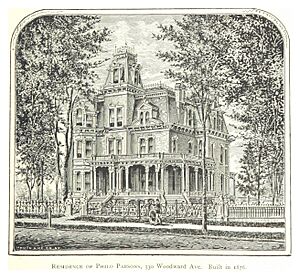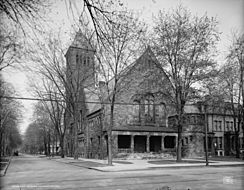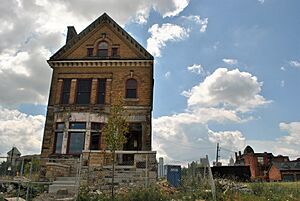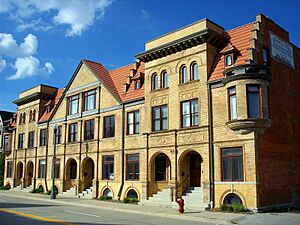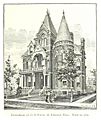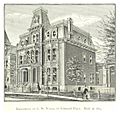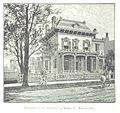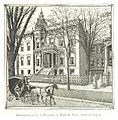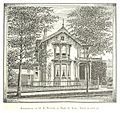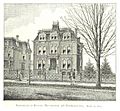Brush Park facts for kids
|
Woodward East Historic District
|
|
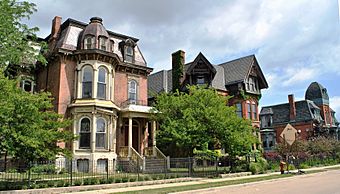
Streetscape on Edmund Place
|
|
| Location | Detroit, Michigan, U.S. |
|---|---|
| Architectural style | Late Victorian, French Renaissance Revival, Second Empire, Italianate |
| NRHP reference No. | 75000973 |
Quick facts for kids Significant dates |
|
| Added to NRHP | January 21, 1975 |
The Brush Park Historic District, often just called Brush Park, is a neighborhood in Midtown Detroit, Michigan. It covers 22 city blocks. The area is bordered by Mack Avenue to the north, Woodward Avenue to the west, Beaubien Street to the east, and the Fisher Freeway to the south. Inside Brush Park is a smaller area called the Woodward East Historic District. This smaller district is on Alfred, Edmund, and Watson Streets, from Brush Street to John R. Street. It is recognized as a special historic place by the National Register of Historic Places.
Brush Park started as a ribbon farm in the 1850s. It was developed by Edmund Askin Brush as a fancy neighborhood for Detroit's richest people. Many beautiful Victorian mansions were built here in the late 1800s. People even called Brush Park "Little Paris" because of its elegant buildings. But this golden age did not last long. By the early 1900s, many wealthy residents moved to newer, quieter areas. Working-class families then moved into Brush Park. The neighborhood faced tough times in the 1970s and 1980s. Many buildings were empty or damaged. Today, Brush Park is being restored. Its historic buildings are being fixed up, and new residents are moving in.
Contents
History of Brush Park
How Brush Park Started
The land where Brush Park now stands was once a ribbon farm. This type of farm was common during the French colonial period. It was first given to Laurence Eustache Gamelin in 1747. Later, the farm was bought by the Barthe family. In the late 1700s, John Askin, a fur trader, got the land through marriage. In 1802, Askin's daughter Adelaide married Elijah Brush. Elijah was a lawyer from Vermont and became Detroit's second mayor. On October 31, 1806, Elijah bought the farm for $6,000.
In the 1850s, Elijah's son, Edmund Askin Brush, started developing the family's land. It was very close to downtown Detroit. He wanted to create a neighborhood for Detroit's most important citizens. The first street, Winder, opened in 1852. Other streets soon followed, named after members of the Brush family. These included Adelaide, Edmund, Alfred, and Eliot. The area was planned very carefully. The lots facing Woodward Avenue were large and expensive. Grand religious buildings and fancy mansions were built there. These homes were as impressive as those on East Jefferson Avenue. The land to the east was divided into smaller, 50-foot-wide lots. Strict rules made sure only high-quality, elegant mansions were built. This gave the neighborhood a fancy and consistent look. In the late 1800s, Brush Park became known as "Little Paris of the Midwest."
Many famous architects designed these mansions. Some of them were Henry T. Brush, George D. Mason, George W. Nettleton, and Albert Kahn. Homes were built in Brush Park starting in the 1860s. The most building happened in the 1870s and 1880s. One of the last homes built was in 1906 by Albert Kahn for himself. Other early residents included lumber baron David Whitney Jr. and his daughter, Grace Whitney Evans. Also, businessman Dexter M. Ferry, Joseph L. Hudson (who started the department store), and banker Frederick Butler lived there.
In the 1890s, the neighborhood began to change. Many German Jewish families moved to Brush Park. The beautiful Temple Beth-El was built during this time. Albert Kahn designed this temple for the Reform Congregation in 1902. Around the same time, the first apartment buildings appeared in Brush Park. The Luben Apartments, built in 1901, were an early example. They had large, luxurious units and a fancy limestone front. Even though they looked nice, apartment buildings meant a slight change in the neighborhood's original high-end feel.
Challenges and Changes
The neighborhood started to decline around 1900. Streetcars and cars made it easier for wealthy people to live farther from downtown. Early residents moved to new areas like Indian Village and Boston–Edison. Brush Park became less popular. The grand mansions along Woodward Avenue were torn down for stores and businesses. Many homes in the area were turned into apartments or rooming houses. This was to house workers from the growing automobile industry. Also, many buildings were removed to create parking lots. By 1921, all the homes on Alfred Street were apartments or rooming houses.
By the 1930s, many African Americans moved into the area. Brush Park became a lively black community. It was near the Black Bottom–Paradise Valley area. Important African American places in Brush Park included St. Peter Claver. This was Detroit's first Catholic church for African Americans. It was founded in 1914. The Most Worshipful Mt. Sinai Grand Lodge, a black masonic lodge, was at 312 Watson. Mercy General Hospital and Clinic was also there. Mercy Hospital was Detroit's first black-owned hospital. Dr. David Northcross founded it in 1917.
The Great Depression and social tensions in the 1940s caused the neighborhood to get worse. Part of the 1943 race riot happened in Brush Park. Russell McLauchlin, who lived there for a long time, described the decline in his 1946 book Alfred Street:
Alfred Street is now in what city-planners call a blighted area. The elms were long ago cut down. No representative of the old neighborfamilies remains. The houses, mostly standing as they stood a half-century ago, are dismal structures. Some have night-blooming grocery stores in their front yards. Some have boarded windows. All stand in bitter need of paint and repair. It is a desolate street; a scene of poverty and chop-fallen gloom; possibly of worse things.
By the 1960s, many buildings were empty and falling apart. But the neighborhood still had much of its historic look. People tried to save it. The first big plan to fix up Brush Park was the Woodward East Renaissance project. It was supposed to finish in 1976. This plan aimed to restore old mansions and build new homes. But it didn't happen because of problems with organization. The area called Woodward East Historic District was recognized as a Michigan State Historic Site in 1974. It was listed on the National Register of Historic Places in 1975. The larger Brush Park Historic District was created by the City of Detroit in 1980. Despite these efforts, by the 1980s, Brush Park was mostly abandoned. It became known as one of Detroit's most run-down areas. Empty buildings were damaged by vandals and fires. Many structures were torn down for safety reasons. In the 1800s, about 300 homes were built in Brush Park, including 70 Victorian mansions. Today, only about 80 original buildings remain. Some notable buildings that were demolished include the Woodward Avenue Baptist Church (1887) and St. Patrick Catholic Church (1862).
Brush Park's Comeback
Brush Park started to come back to life in the 1990s. This revival has sped up since then. New apartment buildings have been built in the southern part of the district. Many of the old mansions have been restored. Some other historic houses were made safe by the City of Detroit in 2005 and 2006. This was for the Super Bowl XL played nearby. A few buildings are still in bad shape and might be torn down.
The French Renaissance style William Livingstone House (1894) on Eliot Street was one of Albert Kahn's first designs. The Red Cross wanted to tear down this mansion. It was originally west of John R. Street. But people who wanted to save old buildings managed to move the Livingstone House about one block east. However, after the move, the house had serious problems with its foundation. This caused the building to slowly fall apart. Artist Lowell Bioleau made a painting of the William Livingstone House. He showed it on the day the house was torn down in 2007. This highlighted the efforts to save historic places.
On May 10, 2014, the historic First Unitarian Church caught fire. The cause was suspicious. The building was then torn down. This church was designed by Donaldson and Meier and built in 1890. It was listed on the National Register of Historic Places. Its loss was a big blow to Brush Park's history.
Important Buildings in Brush Park
| Name | Image | Year Built | Location | Style | Architect | Notes |
|---|---|---|---|---|---|---|
| Alpha Phi Alpha Fraternity House |  |
c. 1918 | 293 Eliot St. | American Foursquare | Unknown | Since 1939, this building has been home to the Gamma Lambda Chapter of Alpha Phi Alpha. This is an African-American Greek-lettered fraternity. It was an important place for black social and community activities. The house was named a Michigan State Historic Site in 1977. |
| Bonstelle Theatre |  |
1902 | 3424 Woodward Ave. | Beaux-Arts, Greek Revival | Albert Kahn; C. Howard Crane (remodeling) | Albert Kahn designed this neoclassical temple for Detroit's Jewish community. It opened in 1902. In 1925, it became a theater. The building is the oldest synagogue building in Detroit. It is listed on the National Register of Historic Places. |
| Max Broock House |  |
1905 | 233 Erskine St. | Edwardian | Mueller & Mildner | This house was built for Max Broock, a real estate broker. It shows a mix of Victorian and 20th-century styles. |
| Frederick Butler House | 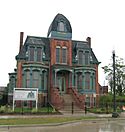 |
1882 | 291 Edmund Pl. | French Renaissance Revival, Second Empire | William Scott & Co. | Built in 1882, this large mansion was owned by banker Frederick Butler. It was restored and turned into condos in 2006. It is now called Edmund Place. |
| James V. Campbell House |  |
1877 | 261 Alfred St. | Italianate | Unknown | James Valentine Campbell was a justice on the Michigan Supreme Court. His family lived in this house from 1877 to 1891. It is part of the Woodward East Historic District. |
| The Carlton | 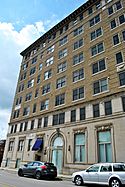 |
1923 | 2915 John R. St. at Edmund | Beaux-Arts, Chicago School | Louis Kamper | The Carlton Plaza Hotel opened in 1924. It was a popular place for wealthy African-Americans, including jazz musicians. In the 1950s, Ebony magazine called it one of the most beautiful hotels for black people in the U.S. It was renovated into condominiums in 2005. |
| Carola Building |  |
1912 | 78 Watson St. | Renaissance Revival | This building has been renovated and turned into condominiums. | |
| Lyman Cochrane House | 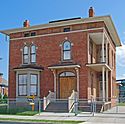 |
1870 | 216 Winder St. | Italianate | This house is a rare example of Italianate style in Detroit. Lyman Cochrane, a state senator and judge, bought it in 1871. | |
| Crystal lofts |  |
1919 | 3100 Woodward Ave. at Watson | Art Deco | This building was originally a ballroom called the Crystal Palace. It was recently renovated into condominiums. Its Art Deco front was added in 1936. | |
| J.P. Donaldson House |  |
1879 | 82 Alfred St. | Queen Anne | Mason & Rice; Gordon W. Lloyd (remodeling) | This house was built for James P. Donaldson, a ship chandler. It was later owned by David Charles Whitney. In 2012, it was used as a movie set for the vampire film Only Lovers Left Alive. |
| Clifford Elliot House |  |
1899 | 305 Eliot St. | Victorian, Edwardian | M.A. Edwards | Built for a grocery executive, this house shows the change from Victorian to Edwardian architectural styles. |
| First Presbyterian Church |  |
1889 | 2930 Woodward Ave. | Richardsonian Romanesque | George D. Mason | George D. Mason designed this church. It is similar to Trinity Church in Boston. When Woodward Avenue was widened in 1936, the entrance porch was moved. The church is listed on the National Register of Historic Places. |
| John P. Fiske House | 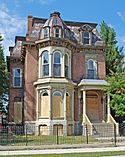 |
1876 | 261 Edmund Pl. | Second Empire, French Renaissance Revival, Victorian | John P. Fiske was a Detroit merchant. This house is in the Woodward East Historic District. It was named a Michigan State Historic Site in 1988. | |
| Ransom Gillis House |  |
1876 | 205 Alfred St. at John R. | Venetian Gothic | Henry T. Brush & George D. Mason | This house was built for Ransom Gillis, a merchant. It is a well-known building in the Woodward East Historic District. |
| Bernard Ginsburg House |  |
1898 | 236 Adelaide St. | Tudor Revival | George W. Nettleton & Albert Kahn | Bernard Ginsburg was important in Detroit's Jewish community. Albert Kahn designed this house, one of his early works. The house is listed on the National Register of Historic Places. |
| John Harvey House |  |
1887 | 97 Winder St. | Second Empire | John V. Smith | John Harvey was a pharmacist. This house has eight marble fireplaces. It was renovated and opened as the Inn at 97 Winder in 2005. The house is listed on the National Register of Historic Places. |
| Hudson–Evans House |  |
1874 | 79 Alfred St. | Second Empire, French Renaissance Revival, Italianate | Unknown | This house was a gift from David Whitney Jr. to his daughter Grace. It later became the home of the Joseph L. Hudson family. It is listed on the National Register of Historic Places. |
| Albert Kahn House |  |
1906 | 208 Mack Ave. | English Renaissance | Albert Kahn | Architect Albert Kahn built this house for himself. He lived here until 1942. Today, the Detroit Urban League uses it. The house is listed on the National Register of Historic Places. |
| George Ladve House | 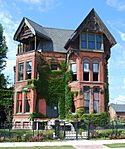 |
1882 | 269 Edmund Pl. | Eastlake Victorian | This Eastlake Victorian style mansion was built for George Ladve. It was restored in 2008. The Frohlich family, who supported the Detroit Symphony Orchestra, later owned it. It is in the Woodward East Historic District. | |
| Lucien S. Moore House | 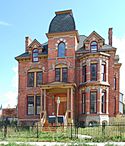 |
c. 1885 | 104 Edmund Pl. | French Renaissance Revival, Gothic Revival | Unknown | This house was built for lumber baron Lucien S. Moore. It was restored in 2006. Its restoration was featured on HGTV. It is also known as the Moorie Town House or The Edmund. |
| Patterson Terrace |  |
1903 | 203-209-213 Erskine St. | Richardsonian Romanesque | This building is currently being renovated. | |
| H.P. Pulling House |  |
48 Edmund Pl. | Victorian | Henry Perry Pulling was a doctor and bank president. | ||
| Emanuel Schloss House |  |
1872 | 234 Winder St. | Second Empire | Unknown | This house was the home of Emanuel Schloss, a merchant. He was an active member of Detroit's Jewish community. The home has been restored and is now an inn. It was named a Michigan State Historic Site in 1988. |
| Horace S. Tarbell House |  |
1869 | 227 Adelaide St. | Victorian, Italianate | This is one of the oldest buildings in Brush Park. Horace Sumner Tarbell, a Michigan Superintendent of Public Instruction, first owned it. It was later abandoned and fell into disrepair. | |
| Elisha Taylor House |  |
1870 | 59 Alfred St. | French Renaissance Revival, Second Empire, Victorian, Gothic Revival | Julius Hess | This house was built for William H. Craig, a land speculator. In 1875, Elisha Taylor bought it. Taylor was a Detroit attorney who held many important jobs. The house is listed on the National Register of Historic Places. |
| Joseph F. Weber House |  |
1901 | 206 Eliot St. | Colonial Revival | Unknown | This house was owned by lumber baron Joseph F. Weber. Its Colonial Revival style is similar to other homes in areas like Indian Village. It was named a Michigan State Historic Site in 1987. |
Schools in Brush Park
Brush Park is part of the Detroit Public Schools district. Students living here go to Spain Elementary School for kindergarten through 8th grade. For high school, they attend Martin Luther King High School.
Images for kids
-
Woodward Avenue Baptist Church built in 1887. It was destroyed by fire in 1986.
-
Grover Salman Wormer Residence in 115 E High street built in 1854 and demolished in the 1960s.
-
Original Woodward Avenue Baptist Church before its 1935 renovation.
See also
 In Spanish: Brush Park para niños
In Spanish: Brush Park para niños


